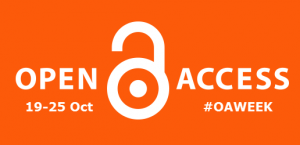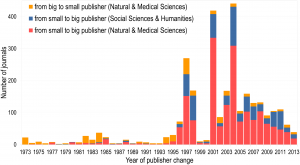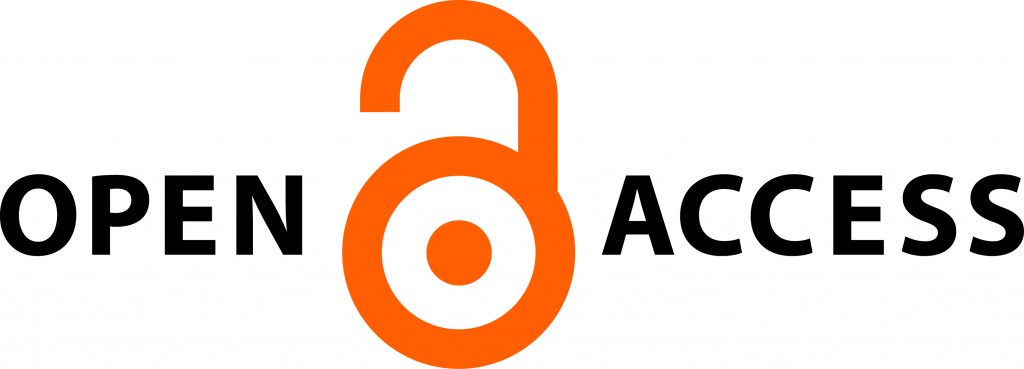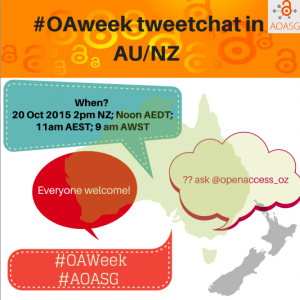Being open (Wed 21 & Fri 23 Oct, 1pm, #OAweek)
Note: the two sessions will be basically the same thing offered in different locations. You don’t need to come to both, though you are welcome to do so.

The nature of scholarship is changing, as are the ways in which you can engage with your research community and beyond. As part of Otago’s Open Access Week events, these sessions will consist of a series of quick fire topics on the theme of ‘being open.’ Those who come along can chose topics they’re interested in, including but not limited to:
- creative commons
- open educational resources (OERs)
- hosting your own journal
- data management (e.g. Figshare)
- ORCID unique researcher identifiers
- Otago University Research Archive (OUR Archive, our institutional research repository), and
- Academic Networking sites (e.g. ResearchGate, Academia.edu), etc.
The quick-fire topics will serve as an invitation to attendees to engage in an open discussion where they can ask questions, share experiences or even get hands-on support. You don’t know a thing about ORCID but you know you want one? Do you apply creative commons licences to your work and want to share your experiences? These sessions will be of use to all students/academics/researchers keen to engage in conversations around open access, the pros and cons and making the most of the various tools available.
When: 1 – 2pm Wednesday 21 October 2015
Where: Science Library Seminar Room (far-right corner from the entrance, see floorplan)
When: 1 – 2pm Friday 23 October 2015
Where: Hunter Centre G30a (ground floor, to the right inside the main entrance)
Open Access. What is it and why should I care? – plus OA baking! (1pm, Mon 19 October, #OAweek)

Why are governments, funders and institutions around the world mandating or encouraging Open Access? What does it mean for my discipline? My department? Me, as an individual researcher or teacher?
Our opening event for OA Week offers an introduction to OA, its demonstrable benefits to the scholarly pursuit and the challenges it presents. This session will provide a broad overview of current developments in OA and examine what the future might hold.
We’ll also be launching a survey of Otago staff, which asks about practices in and attitudes towards OA publishing.
Come along and share your experiences or bring your questions.
As an added bonus there will be open access baking. You’ll have to come find out what that is!
When: 1 – 2pm Monday 19 October 2015
Where: Central Library Conference Room 3 (1st floor East end, see floorplan)
Online: join virtually via Connect
#OAweek tweetchat, virtual OA meetup for AU/NZ
Meet up with others across Australia and New Zealand interested in open access (Tues 20 Oct 2015, 2pm NZ time).
Hashtags #oaweek and #AOASG for the Australasian OA Support Group OA.
Fancy printing your own Homo Naledi bones?
You can, thanks to the researchers behind the most-talked about fossil discovery in recent times releasing research-quality 3D scans on MorphoSource. Any student in the world (whose school or organisation has access to the right printing technology) can hold the bones in their hands.
John Hawkes, a core scientist in the Rising Star Expedition team behind the research, has hailed their work as “a triumph for open access and education”:
The open access philosophy has driven our work on Homo naledi from the beginning. Instead of keeping these discoveries veiled behind locked doors, we have tried to bring them to the public in ways that will drive greater curiosity and engagement with science…
Not only the public benefits from scientific open access; science itself benefits. Showing the process of science in action, we create better tools for educators to equip students with the scientific method.
As we train a new generation of scientists, we must give them the tools to build collaborations and work with massive data. By sharing data openly, we build a worldwide community of practice as we attempt to understand this and other future discoveries.
 Read Hawkes’ full editorial post.
Read Hawkes’ full editorial post.
How much do they pay for journal subscriptions in the UK?
Two independent British researchers have obtained and released data on the licensing fees spent on journal subscriptions in the UK higher education sector. The data, released openly on F1000Research, shows spending by over 150 UK higher education organisations on the journals from ten publishing groups, reaching a total of £430 million from 2010 – 2014. The data, being open, allowed me to do some quick calculations. Across these institutions the total spend in each year showed a steady increase over the five years: £76m, £82m, £88m, £91m and £94 respectively.
These figures are, of course, separate from anything spent on Author Processing Charges now being spent by UK insitutions to comply with goverment-mandated open access to publicly-funded research, which has become a significant cost in itself with the UK government’s support for the Gold OA model.
You can compare 2013 figures to publicly released figures for New Zealand institutions. The highest figure paid among the UK institutions that year was the £3.1 million spent by the University of Manchester. The University of Auckland was the biggest spender of New Zealand institutions in the same year at $14.8 million. The figures are not directly comparable – given that the UK’s include licensing fees for ten specific publishers and the NZ figures are for all spending on academic journal subscriptions — but do provide a broad basis for comparison. Similarly the total spends make interesting reading, with the UK’s £91 million spread across 153 institutions and NZ’s $55 million across just eight universities and eight Crown Research Institutes.
More than half of research published by top five publishers
An analysis of 45 million research documents has found that the top five most prolific publishers account for more than 50% of all papers published in 2013. The digital era precipitated a massive shift from a proliferation of research publishers to an oligopoly of a small handful. This influence is particularly evident in the social sciences (where the share is more like 70%) and less so in the humanities (20%); the Natural and Medical Sciences lie around the half-way point largely because of the independence of the major scholarly socities.
The paper concludes that this massive increase in influence has been largely responsible for the massive rises in profits of these publsihers, without a concomitant increase in added value to what has been described as ‘the most profitiable obsolete technology in history.’
It also concludes that only the academic community – having sold off its intellectual capital at an amazing rate (see image at the bottom of this post) – has the ability to reverse this the ‘acaedmic spring’ of the open access / open science movements.
Read The Oligopoly of Academic Publishers in the Digital Era in full (and open access) at PLoS ONE.
 Number of journals changing from small to big publishers, and big to small publishers per year of change in the Natural and Medical Sciences and Social Sciences & Humanities | CC BY Larivière et al (2015) | doi:10.1371/journal.pone.0127502.g002
Number of journals changing from small to big publishers, and big to small publishers per year of change in the Natural and Medical Sciences and Social Sciences & Humanities | CC BY Larivière et al (2015) | doi:10.1371/journal.pone.0127502.g002
Open Access publishing in the UK
Open access to research is the theme for the month of Febraruy on NZCommons, the home for discussion of all things copyright and open access in New Zealand. The following are some highlights of a post of on open access publishing in the UK by Cambridge academic Dr Rupert Gatti (originally published on The Guardian).
While academia is in the midst of a general funding crisis, multinational publishing houses are making vast profits from disseminating publicly funded research. New Open Access publishing models provide cost-efficient methods for disseminating research findings, eradicate excess profits by publishers and massively widen the readership of scholarly works…
…Our model is now well-honed and successfully spreading knowledge around the world: our books are currently averaging around 500 views per month, which is more than most printed academic books see in an entire lifetime. They are accessed by people in over 180 countries (most academic books are only available in Western university libraries), with large numbers coming from the developing world…
…There’s no reason why there shouldn’t be a creditable Open Access book publisher in every university around the world, but it is going to require a collective shift in the academic mind-set…
Open Access Week Events, 20-24 October
Otago is hosting two Open Access Week events. Join us either on location or from around the country (links below). Twitter hashtag for all the week’s events across the country is #NZOAWeek2014
Whither and thither OA? Taking the bearings of open access journal publishing
Come along to hear where OA scholarly publishing currently stands and where it might be headed.
Melanie Remy, Justin Farquhar, Christy Ballard
12 – 1pm Monday 20 October
In person: Library Cen 3, Information Services Building
Online: https://connect.otago.ac.nz/christy/ (see help for using Connect)
The Media Text Hack & Open Educational Resources
Does your text book meet your needs? Find a new one that’s open and free to adapt. Better yet: write your own new text in a weekend!
Simon Hart, Sarah Gallagher, Richard White
Library Cen 3, Information Services Building
In person: 12 – 1pm Thursday 23 October
Online: https://connect.otago.ac.nz/sarah/ (see help for using Connect)

Image CC BY from openaccessweek.org
Radio NZ reports on “extortionate” tactics of research publishers
$55 million – that’s the figure Radio NZ has reported that NZ universities and Crown Research Institutes pay in subscription fees to academic publishers. The University of Auckland alone spent almost $15m — with Otago spending the second-highest amount of $8.4 — on access to journals that for the most part comprises work done and reviewed by academics around the world for free, after signing their copyright over to the publishers.
You can also listen to the report from Morning Report.
Want massive NZ aerial imagery or map data?
Last week Land Information NZ (LINZ) – which has been leading the way in open access government data for some time – announced they were releasing even more open data into the wild. Their data service now incorporates terrain, street maps and satellite imagery.
 CC BY – LINZ Data Service
CC BY – LINZ Data Service
There’s literally terabytes of it, covering around 95% of the country, which you can download or, if you need more than 3GB, have couriered to you. In a press statement Land information minister Maurice Williamson said:
“Releasing publicly held aerial imagery for reuse has the potential to create cost savings for the public sector and generate economic benefits for the private sector. Imagery can be used to improve productivity in agriculture and forestry, and can be used in construction, engineering, disaster recovery planning, and land and asset management. Making aerial imagery available is in line with the government’s goal to make more publicly held data accessible to as many people as possible.”
It also means whenever you have a student asking where they can get a map or overhead image of somewhere in New Zealand, you’ll know where to send them for an open access one.

